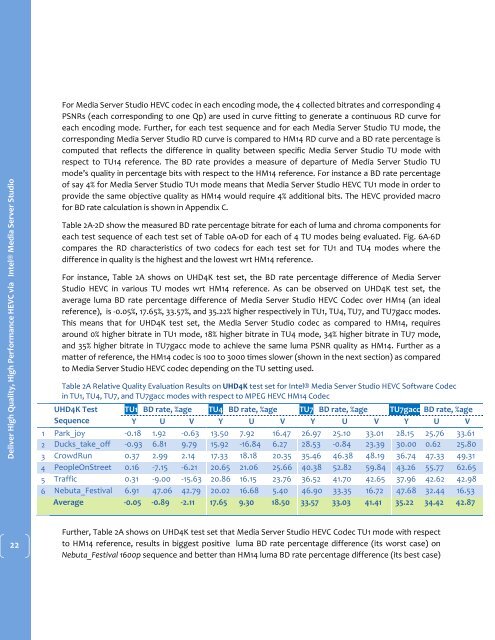Create successful ePaper yourself
Turn your PDF publications into a flip-book with our unique Google optimized e-Paper software.
<strong>Deliver</strong> <strong>High</strong> <strong>Quality</strong>, <strong>High</strong> <strong>Performance</strong> <strong>HEVC</strong> <strong>via</strong> <strong>Intel®</strong> <strong>Media</strong> <strong>Server</strong> <strong>Studio</strong><br />
For <strong>Media</strong> <strong>Server</strong> <strong>Studio</strong> <strong>HEVC</strong> codec in each encoding mode, the 4 collected bitrates and corresponding 4<br />
PSNRs (each corresponding to one Qp) are used in curve fitting to generate a continuous RD curve for<br />
each encoding mode. Further, for each test sequence and for each <strong>Media</strong> <strong>Server</strong> <strong>Studio</strong> TU mode, the<br />
corresponding <strong>Media</strong> <strong>Server</strong> <strong>Studio</strong> RD curve is compared to HM14 RD curve and a BD rate percentage is<br />
computed that reflects the difference in quality between specific <strong>Media</strong> <strong>Server</strong> <strong>Studio</strong> TU mode with<br />
respect to TU14 reference. The BD rate provides a measure of departure of <strong>Media</strong> <strong>Server</strong> <strong>Studio</strong> TU<br />
mode’s quality in percentage bits with respect to the HM14 reference. For instance a BD rate percentage<br />
of say 4% for <strong>Media</strong> <strong>Server</strong> <strong>Studio</strong> TU1 mode means that <strong>Media</strong> <strong>Server</strong> <strong>Studio</strong> <strong>HEVC</strong> TU1 mode in order to<br />
provide the same objective quality as HM14 would require 4% additional bits. The <strong>HEVC</strong> provided macro<br />
for BD rate calculation is shown in Appendix C.<br />
Table 2A-2D show the measured BD rate percentage bitrate for each of luma and chroma components for<br />
each test sequence of each test set of Table 0A-0D for each of 4 TU modes being evaluated. Fig. 6A-6D<br />
compares the RD characteristics of two codecs for each test set for TU1 and TU4 modes where the<br />
difference in quality is the highest and the lowest wrt HM14 reference.<br />
For instance, Table 2A shows on UHD4K test set, the BD rate percentage difference of <strong>Media</strong> <strong>Server</strong><br />
<strong>Studio</strong> <strong>HEVC</strong> in various TU modes wrt HM14 reference. As can be observed on UHD4K test set, the<br />
average luma BD rate percentage difference of <strong>Media</strong> <strong>Server</strong> <strong>Studio</strong> <strong>HEVC</strong> Codec over HM14 (an ideal<br />
reference), is -0.05%, 17.65%, 33.57%, and 35.22% higher respectively in TU1, TU4, TU7, and TU7gacc modes.<br />
This means that for UHD4K test set, the <strong>Media</strong> <strong>Server</strong> <strong>Studio</strong> codec as compared to HM14, requires<br />
around 0% higher bitrate in TU1 mode, 18% higher bitrate in TU4 mode, 34% higher bitrate in TU7 mode,<br />
and 35% higher bitrate in TU7gacc mode to achieve the same luma PSNR quality as HM14. Further as a<br />
matter of reference, the HM14 codec is 100 to 3000 times slower (shown in the next section) as compared<br />
to <strong>Media</strong> <strong>Server</strong> <strong>Studio</strong> <strong>HEVC</strong> codec depending on the TU setting used.<br />
Table 2A Relative <strong>Quality</strong> Evaluation Results on UHD4K test set for <strong>Intel®</strong> <strong>Media</strong> <strong>Server</strong> <strong>Studio</strong> <strong>HEVC</strong> Software Codec<br />
in TU1, TU4, TU7, and TU7gacc modes with respect to MPEG <strong>HEVC</strong> HM14 Codec<br />
UHD4K Test<br />
Sequence<br />
TU1 BD rate, %age TU4 BD rate, %age TU7 BD rate, %age TU7gacc BD rate, %age<br />
Y U V Y U V Y U V Y U V<br />
1 Park_joy -0.18 1.92 -0.63 13.50 7.92 16.47 26.97 25.10 33.01 28.15 25.76 33.61<br />
2 Ducks_take_off -0.93 6.81 9.79 15.92 -16.84 6.27 28.53 -0.84 23.39 30.00 0.62 25.80<br />
3 CrowdRun 0.37 2.99 2.14 17.33 18.18 20.35 35.46 46.38 48.19 36.74 47.33 49.31<br />
4 PeopleOnStreet 0.16 -7.15 -6.21 20.65 21.06 25.66 40.38 52.82 59.84 43.26 55.77 62.65<br />
5 Traffic 0.31 -9.00 -15.63 20.86 16.15 23.76 36.52 41.70 42.65 37.96 42.62 42.98<br />
6 Nebuta_Festival 6.91 47.06 42.79 20.02 16.68 5.40 46.90 33.35 16.72 47.68 32.44 16.53<br />
Average -0.05 -0.89 -2.11 17.65 9.30 18.50 33.57 33.03 41.41 35.22 34.42 42.87<br />
22<br />
Further, Table 2A shows on UHD4K test set that <strong>Media</strong> <strong>Server</strong> <strong>Studio</strong> <strong>HEVC</strong> Codec TU1 mode with respect<br />
to HM14 reference, results in biggest positive luma BD rate percentage difference (its worst case) on<br />
Nebuta_Festival 1600p sequence and better than HM14 luma BD rate percentage difference (its best case)


